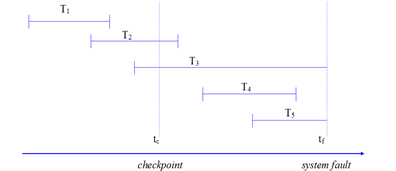MC Which statement is NOT CORRECT? Archiving is an approach in which database files are copied periodically to other storage media, such as tape or (another) hard disk. incorrect Disk mirroring is a (near) real time approach that writes the same data simultaneously to two or more physical disks incorrect There is a trade-off between the cost (overhead and storage cost) of more frequent backups and the cost of lost data because of less frequent backups. incorrect Traditional relational databases allow for a certain measure of temporary inconsistency, in return for increased performance. correct
MC The following figure presents five transactions (T1 until T5) that are executed more or less simultaneously. Suppose a checkpoint was registered on the logfile at time tc, marking the last time when pending updates in the database buffer were persisted into the physical database files. Later, at time tf, a system fault occurred, resulting in loss of the database buffer.

What recovery operations are required? T1: nothing; T2: REDO; T3: UNDO; T4: REDO; T5: nothing correct T1: nothing; T2: REDO; T3: REDO; T4: REDO; T5: nothing incorrect T1: REDO; T2: UNDO; T3: REDO; T4: nothing; T5: nothing incorrect T1: nothing; T2: UNDO; T3: REDO; T4: REDO; T5: nothing incorrect
MC Which statement is NOT CORRECT? Disk mirroring is a (near) real time approach that writes the same data simultaneously to two or more physical disks incorrect There is a trade-off between the cost (overhead and storage cost) of more frequent backups and the cost of lost data because of less frequent backups. incorrect Traditional relational databases allow for a certain measure of temporary inconsistency, in return for increased performance. correct Archiving is an approach in which database files are copied periodically to other storage media, such as tape or (another) hard disk. incorrect
MC The following figure presents five transactions (T1 until T5) that are executed more or less simultaneously. Suppose a checkpoint was registered on the logfile at time tc, marking the last time when pending updates in the database buffer were persisted into the physical database files. Later, at time tf, a system fault occurred, resulting in loss of the database buffer.

What recovery operations are required? T1: nothing; T2: REDO; T3: UNDO; T4: REDO; T5: nothing correct T1: REDO; T2: UNDO; T3: REDO; T4: nothing; T5: nothing incorrect T1: nothing; T2: REDO; T3: REDO; T4: REDO; T5: nothing incorrect T1: nothing; T2: UNDO; T3: REDO; T4: REDO; T5: nothing incorrect
MC Which statement is NOT CORRECT? The logfile contains all updates after they have been written to disk. correct The logfile can be implemented as a sequential file. incorrect The logfile contains redundant data. incorrect The logfile is often duplicated, e.g. in a RAID level 1 configuration. incorrect
MC If the precedence graph contains a cycle, the schedule is... serializable incorrect not serializable correct
MC If the precedence graph contains a cycle, the schedule is... not serializable correct serializable incorrect
MC When a transaction is aborted, it is important that: A rollback of the transaction is executed: all changes made by the transaction's respective operations should be undone. correct All changes made by the individual operations belonging to that transaction should be made permanent. incorrect
MC If the precedence graph contains a cycle, the schedule is... not serializable correct serializable incorrect
MC Which statement is CORRECT? Multiple transactions may hold a shared lock on the same object. correct Multiple transactions may hold an exclusive lock on the same object. incorrect

